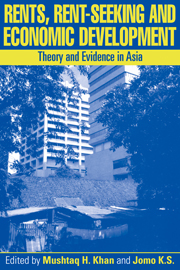Book contents
- Frontmatter
- Contents
- List of Figures
- List of Tables
- List of Contributors
- Acknowledgements
- List of Abbreviations
- Introduction
- 1 Rents, Efficiency and Growth
- 2 Rent-seeking as Process
- 3 Rent-seeking and Economic Development in Thailand
- 4 Thailand's Old Bureaucratic Polity and Its New Semi-democracy
- 5 Obstructive Corruption: The Politics of Privilege in the Philippines
- 6 Funny Money: Fiscal Policy, Rent-seeking and Economic Performance in Indonesia
- 7 The Malaysian Development Dilemma
- 8 Financial Sector Rents in Malaysia
- Index
4 - Thailand's Old Bureaucratic Polity and Its New Semi-democracy
Published online by Cambridge University Press: 05 March 2012
- Frontmatter
- Contents
- List of Figures
- List of Tables
- List of Contributors
- Acknowledgements
- List of Abbreviations
- Introduction
- 1 Rents, Efficiency and Growth
- 2 Rent-seeking as Process
- 3 Rent-seeking and Economic Development in Thailand
- 4 Thailand's Old Bureaucratic Polity and Its New Semi-democracy
- 5 Obstructive Corruption: The Politics of Privilege in the Philippines
- 6 Funny Money: Fiscal Policy, Rent-seeking and Economic Performance in Indonesia
- 7 The Malaysian Development Dilemma
- 8 Financial Sector Rents in Malaysia
- Index
Summary
Scholarship on Thailand suffers from an enduring paradox. While political scientists (e.g. Girling 1981; Morell and Chai-Anan 1981) decry a rent-seeking feudalization of administration in both the old bureaucratic polity and the new semi-democracy, economists (e.g. World Bank 1993; Muscat 1994) herald pragmatism and conservatism in economic policy. Where one saw patron–client ties, lack of interest in developmental outcomes, incessant struggles for control over the machinery for extraction of rents, and a congenital inability to make hard decisions, the other saw sound macroeconomic management, limited intervention in markets, an ability to avoid making major mistakes and impressive successes in family planning, public health and education.
Prior to the financial and currency crises of 1997, it was difficult to disagree with the economists. Between 1955 and 1988, per capita economic growth in Thailand averaged 3.9 per cent per year (Christensen et al. 1993: 2). Only four countries – Brazil, Malaysia, Taiwan and South Korea – grew faster. High economic growth was accompanied by a rapid decline in the incidence of poverty and substantial exports of manufactures. An export and foreign investment boom after 1988 contributed to an even faster rate of growth (6.4 per cent per capita per year between 1989 and 1992). This long-term development performance has made Thailand one of the development success stories since 1960. Not surprisingly, the World Bank (1993) included it among the high-performing Asian economies in its East Asian Miracle study.
- Type
- Chapter
- Information
- Rents, Rent-Seeking and Economic DevelopmentTheory and Evidence in Asia, pp. 182 - 206Publisher: Cambridge University PressPrint publication year: 2000
- 10
- Cited by



